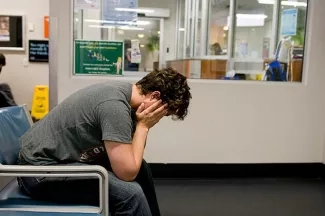Why It Matters

In 2009, I was the chief of one of the busiest emergency departments in California. More than 300 patients a day presented to our 41-bed ED.
That same year, Sacramento County closed its crisis stabilization unit, including half of all inpatient beds in our county psychiatric hospital, to slash $14 million from its budget. Since the closures were not due to a lack of demand, the people in need of behavioral health services still needed treatment. With nowhere else to go, they sought care in all of the emergency departments in our city.
Typically, these patients were seen by an emergency physician; assessed by a psychiatry team, whose goal was to decide if the patient needed psychiatric admission or not; and then boarded in a corner of the ED until an inpatient bed was available. There were times when patients waiting for inpatient psychiatric placement filled over half of the ED beds. Some waited days, and I remember one patient with schizophrenia who was in our ED for more than 12 days.
I felt helpless and had no idea how to improve the situation for patients and my department. I was then fortunate enough to meet an innovative psychiatrist from New York, Dr. Yener Balan. He asked me a simple question when I described what was happening my ED: You treat all of your patients with medical problems — why aren’t you treating your patients with behavioral health issues?
It was a very good question. Would we do this with any other type of patient? Would we ever put all of “the pneumonias” in a corner together without treatment for days at a time? No, and yet this flawed model of care is typical in most emergency departments.
The Need for Fundamental Change
There needs to be a fundamental shift in how we care for psychiatric patients in emergency departments. Leaving a patient with psychosis untreated for days is not good medical care and potentially puts patients and staff at risk. We must move from “assessment and boarding” to:
- Assessment
- Treatment ASAP
- Reassessment
- Discharge when possible
To create capacity in a system, a systematic operations management approach is helpful. With this method, there are three ways to create capacity for patients who need emergency behavioral health care: decrease arrivals to a system, decrease length of stay, or increase the number of beds available. Since the final option is not feasible for most organizations, let’s focus on the first two alternatives.
It is critical to take a systems approach to avoid focusing solely on what is happening locally in your emergency department and consider how a change in the ED might affect another part of the system. For example, if you treat patients with behavioral health issues in the ED and are able to discharge them from there, you will decrease arrivals to the psychiatric hospital and create more treatment capacity in the community. Active treatment with medications in the emergency department can also decrease length of stay for patients who require hospitalization. This also creates capacity.
It’s also important to avoid shortsightedness and think creatively when making resource decisions. For instance, it often makes sense to hire staff specifically to care for patients with psychiatric needs because the decrease in length of stay in the ED can ultimately offset staffing costs. If this is not possible, consider options like telepsychiatry. Also, find out who in your community might be offering grants or other resources for which your organization might qualify.
By taking a hard look at the behavioral health needs for patients presenting to our hospital’s ED and redesigning how we cared for such patients, we were able to improve overall flow in the ED.
LEARN MORE: IHI Hospital Flow Professional Development Program
Tips for How to Start
To improve behavioral health care in the ED, these two steps can get you started:
- Set a goal of giving the same excellent care to patients with behavioral health needs that you give to all patients. Basic training is essential because emergency staff typically have minimal training in psychiatry, most of which focuses on medical clearance and de-escalation of violent patients.
- Start treatment as soon as possible. In our ED, we found that the vast majority of patients with behavioral health needs improve with medications. Since the emergency department physician is usually the first person to see the patient, in my organization the ED and the psychiatry team now agree that the ED physician will give the first dose of medication unless the treatment plan requires additional psychiatric consultation.
Lessons Learned the Hard Way
A report released in 2015 determined that the 2009 budget cuts to behavioral health services in Sacramento County not only increased the suffering of some of the most vulnerable members of our community, it also failed to save money. Instead, the cutbacks passed costs along to hospitals, jails, and law enforcement. Other communities in the US are facing similarly tough budget choices. We hope others can learn from this mistake in our county as well as from the changes we’ve made that led to improvements.
Karen Murrell, MD, MBA, is Chair of Emergency Medicine for TPMG Northern California as well as Assistant Physician in Chief for Hospital Operations at Kaiser South Sacramento Medical Center. She is faculty for IHI’s IHI Hospital Flow Professional Development Program.
